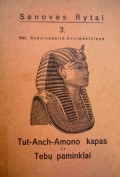 Authors:
Rudzinskaitė-Arcimavičienė, Marija
Authors:
Rudzinskaitė-Arcimavičienė, Marija Catalog: (Lietuvių) Senovės Rytai, (Lietuvių) 3
Published in: Kaunas
Published on: 1933
Publisher: Raidė
“The Tomb of Tut-Ankh-Amun and the Monuments of Thebes“ is the 3rd book in “Ancient East“ series, in which autor of the book, pioneer of profesional Egyptology in Lithuania, Marija Rudzinskaitė-Arcimavičienė, vividly and poeticly portray impressions experienced during her second expedition to Egypt in 1924.
The book is divided into two parts. In the first part of the book the discovery of Tut-Ankh-Amun’s, 12th Egyptian pharaoh of the 18th dynasty (ruled ca. 1332–1323 BC ), tomb is described in fine detail, the most interesting observations of tombs discoverers and explorers (English archaeologists, Egyptologists, George Carnarvon, Howard Carter ) are cited, the history of excavations in the Valley of the Kings are briefly discussed. In the second part of the book, M. Rudzinskaitė-Arcimavičienė depicts her journey to the tomb of Tut-Ankh-Amun and monuments of Thebes (earthen houses fellah village, pharaoh Hatshepsut temple ruins, Luxor temple, ruins of Karnak) in the form of diary.
This small (only 64 pages) book is richly illustrated by unique photographys, drawings, schemes and maps, and this helps the reader to immerse deeply, and experience the events described by the author. The book is easy to read, inclusive. Exellent choice for those who are interested, or wants to know more about mysterious Ancient Egyptian civilization.
Marija Rudzinskaitė-Arcimavičienė – researcher, Egyptologist. She visited Egypt for the first time in 1915, while still studying Ancient civilizations in Moscow. After the first expedition she was so fascinated by the culture of this exotic country, that decided to dedicate her entire life to exploration of Egypt historical legacy. By the initiative of the scientist, the course of history of Egypt started in Vytautas Magnus university in 1922. Other books about Ancient Egypt, written by the same author includes: “The status of the women in Ancient Egypt“, “Name meaning in Ancient Egypt “, “Egyptian hierohlyphs“, “Aigiptas“.
